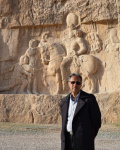| نویسندگان | Parviz Holakoui,Amir Hoseyn Karimi,Rebecca Piovesan,Javad Hoseynzade sadati,Mohsen Javeri,Fabrizio Antonelli,Lara Maritan |
|---|---|
| نشریه | journal of Archaeological and Anthropological Sciences |
| شماره صفحات | 1 |
| شماره مجلد | 14 |
| ضریب تاثیر (IF) | 1.989 |
| نوع مقاله | Full Paper |
| تاریخ انتشار | 2022-03-05 |
| رتبه نشریه | علمی - پژوهشی |
| نوع نشریه | الکترونیکی |
| کشور محل چاپ | ایران |
| نمایه نشریه | SCOPUS ,JCR |
چکیده مقاله
The contents of fve Iron Age I–II (1200–900 BC) small ceramic vessels similar to ancient kohl pots excavated from the graves of the archaeological site of Estark–Joshaqan, near Kashan in central Iranian plateau, were characterised by optical microscopy (OM), X-ray powder difraction (XRPD), micro X-Ray fuorescence (μ-XRF), micro-Raman spectroscopy (µ-Raman) and feld emission scanning electron microscopy coupled with energy-dispersive X-ray spectrometry (SEM–EDS). The analytical data demonstrated that the pots were flled with powdery white laurionite (peculiar fbrous shape) and lead (hydr)oxychloride crystals to which manganese and iron oxides were added to obtain grey and orangish colours, respectively. The occurrence of minerals such as leadhillite, cerussite, anglesite, wulfenite and vanadinite together with barite, celestine, gypsum and anhydrite was ascertained via diferent analytical techniques and was discussed in an archaeological and technological context. In addition, the possible occurrence of mereheadite, with a fbrous habit, has been discussed. These small pots were used as kohl containers for storing cosmetics and placed in the burials as grave goods.
